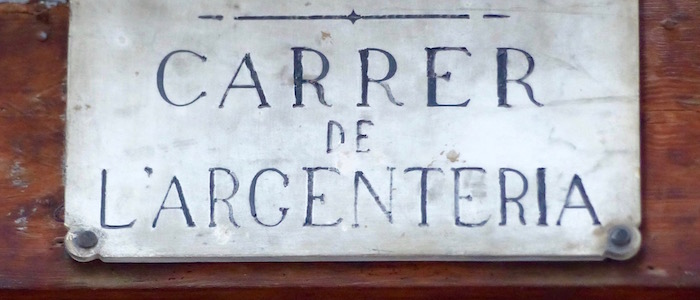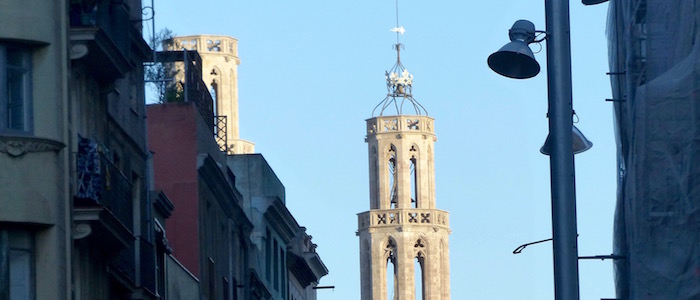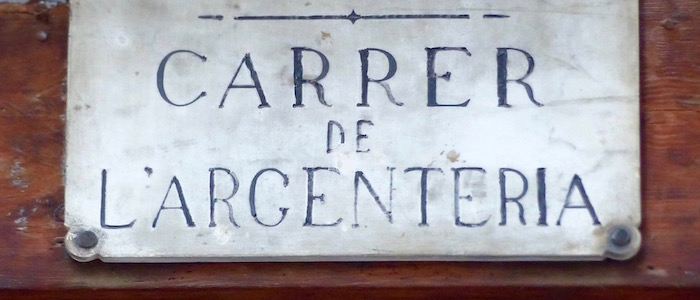

Self-guided The King & trades. Point of interest (10) Carrer de l’Argenteria. Main street of the Ribera.
This neighborhood reinvented itself, and the streets were named after the different trades. Carrer Argenteria was the street where jewelers gathered, and where the most expensive shops were located. We can imagine it as the most emblematic street in those days. The artisans competed among themselves to excel in their trade.
The King and trades.
On one occasion, the king wanted to know which of the trades needed the most ingenuity and which had the most merit of all, to appoint that person the king of trades. He called the seven most recognized masters of each of the most important trades and asked each of them to bring him a sample of their work and the most important tool for its execution. He invited them to a great lunch.
Once they had eaten, each one showed the result of their work and the tool they had used and explained the particularities of their trade. The baker brought a very large loaf and the shovel he needed to put it in the oven. The shoemaker brought a pair of highly polished and shiny shoes and the needles he used to sew them. The tailor brought a very beautiful and shiny dress and the scissors with which he had cut the cloth.
The blacksmith
The blacksmith brought a very beautiful and complex key and the hammer with which he struck the anvil. The tanner brought a very soft tanned hide and the knife that he used to work on it. The carpenter brought a very well-polished box and the tool with which he polished the wood. And the master of houses, since he couldn’t bring a house, took a tile and the trowel and told how he worked.
The seven men explained to the king how they had made the sample piece that they brought to him, how they had used the tool they showed, and even what other tools they had used to made their product.
The King proposal
The king, after checking all the samples and all the tools and having listened carefully, decided that the work that had the most merit was the dress made entirely by hand by the tailor, with no intervention other than a small, simple needle. While all the other craftsmen, in order to finish their work, had used other tools. All the other craftsmen thought that the king had made a mistake, they thought that their own work was of much more merit and skill than the tailor’s work. But, in front of the king, no one had the audacity to claim such a thing, and the tailor was named as the king of all trades.
Of all the attendees, the blacksmith was considered to be the most outraged, to such an extent that he was not willing to have a tailor as king and decided to close the blacksmith shop and leave the city. Soon afterward, the tailor’s scissors were disassembled, the shoemaker’s pliers wore out, the tanner’s knife became dull, the carpenter’s blade broke off, and the master builder’s palette deteriorated.
Everyone needed the blacksmith because no one could do their work without his help. They all went to explain their difficulties to the king, who raised a controversy. He sent out a call to every corner of his kingdom, asking the blacksmith to return. But the blacksmith did not appear; until the king ordered that the blacksmith shop be opened again and that the forge be turned on.
Self-guided The King & trades
He asked everyone who considered that he could work as a blacksmith to fix the tools of the other craftsmen, since no one could work without the help of the blacksmith. Each of the interested people tried and tried to fix the tools, but none succeeded.
Many people from other trades showed up to see if they could resolve the conflict, but to no avail, and as time passed, more controversy was generated because every day more tools from other trades wore out. One day, the blacksmith finally came back, since the calls of the king reached him. He fixed the tools of all the craftsmen, and peace was restored between all trades.
The king called the seven artisans to another brotherhood meal, and in front of everyone, he confessed that he had made a mistake and that reality had shown that all trades depended on the blacksmith, without whom they could not make or repair the tools of the other trades. In front of everyone, the king appointed the blacksmith as king of all trades in agreement with the rest of the craftsmen.
The tailor, as an act of loyalty to his trade king, knelt at his feet and made seven notches with his scissors at the bottom of the apron of the blacksmith. Always, wore to protect his clothes from the sparks of the forge. Even in modern times, the blacksmiths of forges wear an apron with seven notches at the bottom, which in addition to making it look nice, are an offering from tailors and the royal emblem among other trades.
At that time, craftsmen working with wood were merged into a single trade body. Carpenters made wooden houses as well as furniture and boats. The carpentry trade required the most skill, because they knew everything and knew how to do everything as long as it involved wood.
King result
The king, astonished by the prodigious skill of the carpenters, wanted to establish them in a kind of kingdom and appoint a king among them. He made a great call, offering the option of creating the king of carpenters. He asked, he who would do the most perfect and important work to show it to the court. Furthermore, he summoned all those who wanted to opt for the title of king of carpenters.
Three of them came before the best of the court and the wisest and most expert people. They worked for many days, until they finished the work they had chosen themselves. One made a spiral staircase, another made a boat, and the other a wagon wheel. The three works were recognized for their perfection, exceptional ingenuity, notable merit and great utility, to such an extent that neither the king nor any of his counts knew which of the three to choose.
After much deliberation, the king called all three carpenters kings. Since it was impossible for three kings to exist.
The King moral
It was agreed that the carpenters would divide the tasks and that they would perform three trades: the carpenters who would make the houses; riverside carpenters, who would make boats, and carriage masters. And each of the three kings would be the king of each of the three trades.
It was then that one of the carpenters stopped making his wooden objects… do you know what happened then…? The story started again…
Moral of the Self-guided The King & Trades: it is best not to be jealous of others, let the skills of others flow, so you can stand out with your abilities, look for positivity in your own strength. Point of interest (8) Plaça de Santa Maria del Mar. Carrer Caputxes and Carrer Sombreres.
Category: Barcelona walking Tags:
Contact and Booking
Mobile: +34649970408 pere.sauret10@gmail.com
Experiences
Hiking Walking Rock-climbing
Donate
Copyright © 2025 · All Rights Reserved · BarcelonaWalking Barcelona Hiking Barcelona Montserrat Costa Brava Pyrenees
Adventure Theme by Organic Themes · WordPress Hosting · RSS Feed · Log in
 BarcelonaWalking Barcelona Hiking Barcelona Montserrat Costa Brava Pyrenees
BarcelonaWalking Barcelona Hiking Barcelona Montserrat Costa Brava Pyrenees
